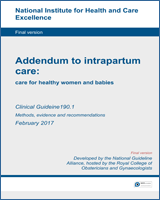From: Appendix I, GRADE tables

Addendum to intrapartum care: care for healthy women and babies.
Clinical Guideline, No. 190.1.
National Guideline Alliance (UK).
London: National Institute for Health and Care Excellence (NICE); 2017 Feb.
Copyright © National Institute for Health and Care Excellence 2017.
NCBI Bookshelf. A service of the National Library of Medicine, National Institutes of Health.